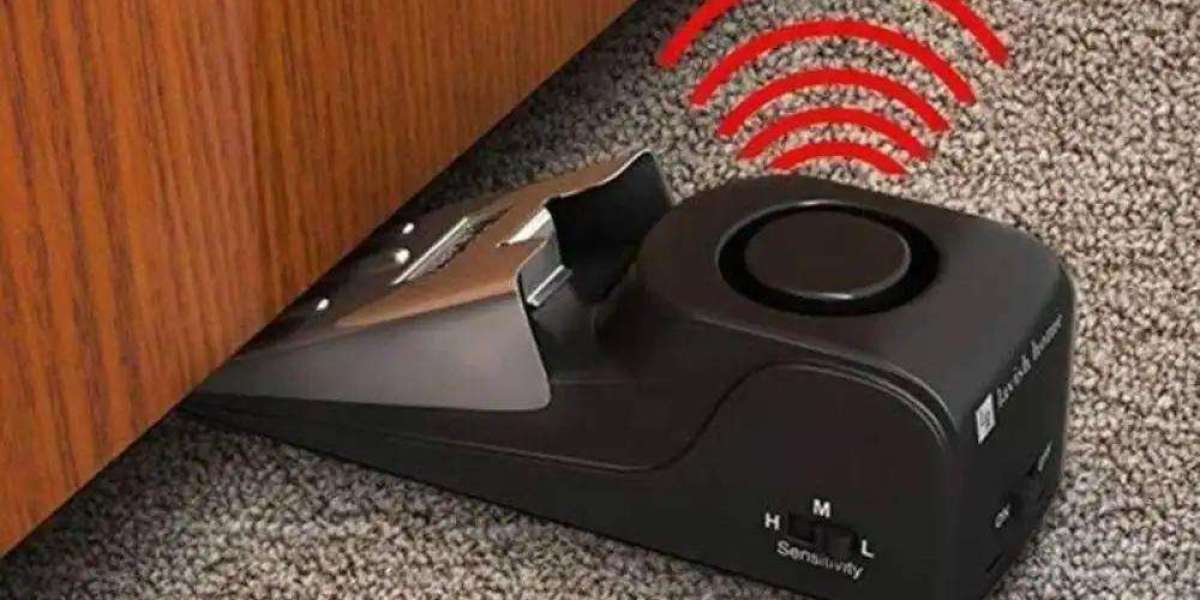In today's world, ensuring the security of your home is more critical than ever. With the rise in burglary attempts and unauthorized entries, having robust security measures in place is essential. While high-tech security systems can be effective, they can also be expensive. This is where a door stop alarm comes in—an affordable, easy-to-use device that can significantly enhance the security of your home.
A doorstop alarm is a small yet powerful device that combines the simplicity of a traditional doorstop with the added security of an alarm system. It is placed under the door, and when pressure is applied, it emits a loud alarm, alerting you and potentially scaring off intruders. This blog will delve deep into how a door stop alarm works, its benefits, installation, and tips for choosing the best one for your needs.
How Does a Door Stop Alarm Work?
You understand how doorstop alarms function, and it is essential to appreciate their role in home security. The device operates on a simple mechanism. When you place the Alarm under your door, it serves as a wedge, preventing the door from being opened. Simultaneously, if an attempt is made to force the door open, the pressure applied triggers the Alarm, which emits a loud sound—usually around 120 decibels. This noise is loud enough to wake you up if you're sleeping and to deter intruders from continuing their attempts.
Most doorstop alarms are battery-operated and have sensitivity settings, which allow you to adjust the level of force required to trigger the Alarm. This feature is handy in different environments, as a high-sensitivity setting can be employed in places with less frequent use. In contrast, a lower setting might be more suitable for high-traffic areas.
Benefits of Using a Door Stop Alarm
There are several advantages to incorporating a doorstop alarm into your home security system. These include:
- Affordability: Compared to sophisticated home security systems, doorstop alarms are very cost-effective. They provide a high level of security at a fraction of the cost, making them accessible to everyone.
- Ease of Use: One of the most significant advantages of a door stop alarm is its simplicity. There is no need for complicated installations or wiring. You place it under the door, and it's ready to go.
- Portability: Doorstop alarms are lightweight and portable, making them perfect for travelers. Whether you're staying in a hotel or renting an Airbnb, you can easily carry your doorstop alarm with you to ensure your safety on the go.
- Versatility: These alarms are not just for home use. They can be used in dorm rooms, offices, and even garage doors. Anywhere you want an additional layer of security, a door stop alarm can be employed.
- Preventive Measure: The loud noise emitted by the Alarm can deter potential intruders, often preventing a break-in before it happens. This preemptive action is invaluable, especially during the night when everyone is asleep.
- No Power Dependency: Since most door stop alarms are battery-operated, they don't rely on electricity. This feature is particularly beneficial in cases of power outages when other security systems might fail.
Choosing the Right Door Stop Alarm for Your Needs
With the variety of door stop alarm available on the market, choosing the right one for your needs can be overwhelming. Here are some factors to consider:
- Sensitivity Settings: Look for an alarm that offers adjustable sensitivity. This feature allows you to customize the Alarm's response to different pressure levels, making it more versatile.
- Sound Level: The decibel level of the Alarm is crucial. Most effective doorstop alarms will have a sound level of around 120 decibels, which is loud enough to be heard throughout your home and even by neighbors.
- Build Quality: Ensure that the door stop alarm you choose is made of durable materials. The wedge should be strong enough to withstand force without sliding.
- Power Source: Check whether the Alarm is battery-operated or rechargeable. While both have their advantages, battery-operated alarms are generally more convenient for travel.
- Size and Portability: If you plan to use the Alarm while traveling, consider its size and weight. A compact, lightweight design is ideal for portability.
- Additional Features: Some doorstop alarms come with extra features like LED indicators, low battery warnings, or even Wi-Fi connectivity for remote monitoring. These additional features can enhance the functionality of the Alarm.
How to Install and Use a Door Stop Alarm
Installing and using a door stop alarm is straightforward, but to get the most out of it, follow these steps:
- Choose the Right Door: Place the Alarm under a door that is vulnerable to forced entry. This could be your front door, back door, or even a door leading to the garage.
- Position the Alarm Correctly: Ensure that the wedge is firmly under the door, with the alarm part facing inward. This positioning will ensure that any attempt to open the door will trigger the Alarm.
- Adjust the Sensitivity: If your Alarm has adjustable sensitivity settings, set it to the desired level. For high-risk areas, a higher sensitivity might be more appropriate.
- Test the Alarm: Before relying on the Alarm, test it by applying pressure to the door. Ensure that the Alarm sounds as expected.
- Maintain the Alarm: Regularly check the battery level and replace it as needed. A low battery can reduce the effectiveness of the Alarm, so it's crucial to keep it in optimal condition.
Practical Tips for Maximizing the Effectiveness of Your Door Stop Alarm
While a door stop alarm is a powerful tool for enhancing security, following some best practices can maximize its effectiveness:
- Use Multiple Alarms: For larger homes or spaces with multiple entry points, consider using more than one doorstop alarm. This approach ensures that all potential entry points are secured.
- Combine with Other Security Measures: While a door stop alarm is effective, combining it with other security measures like CCTV cameras, motion sensors, and secure locks can create a comprehensive security system.
- Regularly Update Your Security Setup: Periodically review and update your security setup to address any new vulnerabilities. This could involve changing the position of your door stop Alarm or adding new devices.
- Educate Your Family: Ensure that everyone in your household knows how to use the door stop alarm. This knowledge is essential for children and elderly family members who might be home alone.
Common Misconceptions About Door Stop Alarms
Despite their effectiveness, there are some common misconceptions about doorstop alarms:
- Only for Doors: While primarily designed for doors, doorstop alarms can also be used in other applications, such as securing windows or sliding doors.
- Only for Home Use: These alarms are versatile and can be used in various settings, including offices, dormitories, and even during travel.
- Not Effective Against Experienced Burglars: A door stop alarm may not be effective against experienced burglars. However, the loud noise emitted by the Alarm is a significant deterrent, regardless of the intruder's experience level.
- Limited Lifespan: Some users think that the batteries in door stop alarm don't last long. However, with proper maintenance and timely battery replacement, these alarms can serve you well for years.
Conclusion
In conclusion, a door stop alarm is a simple yet highly effective device that can significantly enhance the security of your home. Its affordability, ease of use, and portability make it a must-have for anyone looking to improve their home security without breaking the bank. By choosing the right door stop alarm and following the tips outlined in this guide, you can ensure that your home remains a safe and secure haven.








